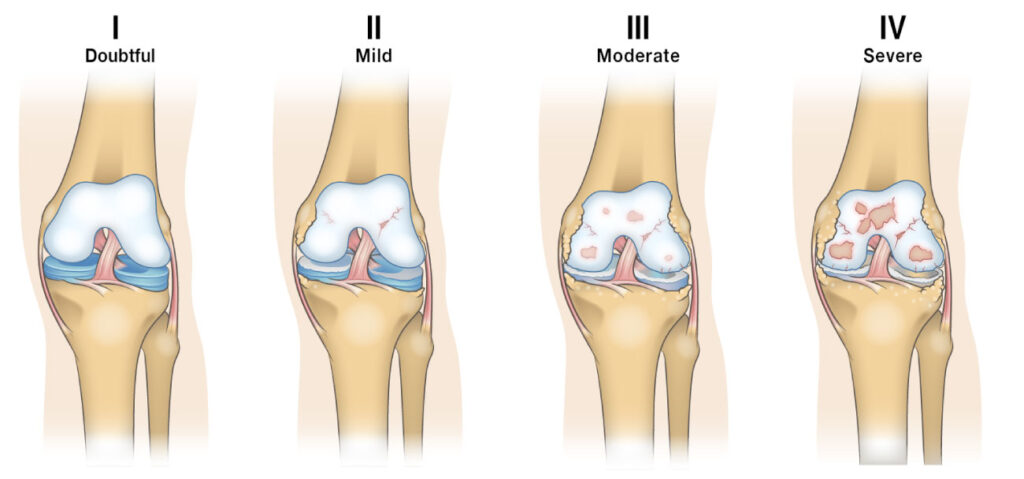
Osteoarthritis of the Knee
Osteoarthritis of the Knee:

Osteoarthritis of the knee occurs when the protective cartilage within the knee joint deteriorates, leading to increased friction between the bones. This degeneration can result in pain, stiffness, and occasional swelling in the knees. Although a definitive cure for knee osteoarthritis is currently unavailable, various treatments exist to decelerate its advancement and alleviate associated symptoms. In more advanced cases, surgical interventions may be considered. For further information and personalized guidance on managing osteoarthritis.
Knee osteoarthritis is highly prevalent, affecting a significant portion of the population.Studies suggest that around 46% of individuals will experience this condition at some point in their lives.
Osteoarthritis Types and Their Impact on the Knee:
Osteoarthritis in the knee primarily manifests through persistent knee pain, significantly impacting your ability to engage in activities like jogging, running, climbing stairs, or kneeling. This condition may also lead to stiffness and swelling in the knees. As time progresses, the effects of knee osteoarthritis can even alter the shape of the knee joint, contributing to a sensation of instability or wobbliness.
1.Osteoarthritis:
Osteoarthritis of the knee occurs when the cartilage in your knee joint undergoes wear and tear or sustains damage. This articular cartilage, a resilient and rubbery tissue covering the ends of your bones, facilitates bending and movement.
Similarly to a car’s shock absorber protecting it from bumps, the meniscal cartilage in your knee absorbs shock from pressure.
Several factors contribute to the breakdown or damage of knee joint cartilage:
Being overweight:
Individuals with a body mass index (BMI) of 30 or higher are seven times more likely to develop knee osteoarthritis than those with a lower BMI.
- Knee injuries:
Past or recent injuries to the knee can increase the risk of osteoarthritis.
- Repetitive stress on the knee:
Regularly subjecting your knee to stress, either through occupational activities or sports, can contribute to cartilage wear and tear.
- Genetic predisposition:
Inherited tendencies can make individuals more susceptible to developing osteoarthritis of the knee.
Structural factors:
Having crooked bones or joints, such as knocked knees, can impact the distribution of stress on the knee joint, potentially leading to osteoarthritis.
The primary symptom of osteoarthritis in the knee is pain, which can occur during movement or even when at rest. Additional symptoms include:
Stiffness:
Particularly noticeable when getting up or after prolonged periods of sitting.
Swelling:
The knee may appear swollen or feel puffy.
Audible noises: Cracking or grinding sounds may be heard when moving the knee.
Instability:
A sensation of wobbliness in the knee, as if it could buckle or give out.
Locking:
The knee may occasionally lock up or feel stuck.

Symptoms and Causes:
Osteoarthritis of the knee occurs when the cartilage in the knee joint undergoes wear and tear or sustains damage. This resilient, rubbery tissue, known as articular cartilage, covers the ends of your bones, facilitating smooth bending and movement. Similar to a car’s shock absorber protecting it from bumps, the meniscal cartilage in your knee absorbs shock from pressure.
Several factors contribute to the breakdown or damage of knee joint cartilage, including:
Weight-related factors: Individuals with a body mass index (BMI) of 30 or higher are seven times more likely to develop knee osteoarthritis.
Knee injuries: Past or recent injuries to the knee can increase the risk of osteoarthritis.
Repetitive stress: Regularly subjecting your knee to stress, whether through occupational activities or sports, can contribute to cartilage wear and tear.
Genetic predisposition: Inherited tendencies can make individuals more susceptible to developing osteoarthritis of the knee.
Structural factors: Having crooked bones or joints, such as knocked knees, can impact the distribution of stress on the knee joint, potentially leading to osteoarthritis.
Are you experiencing osteoarthritis of the knee?
There are two ways to initiate a consultation with Dr. Ravi Teja Rudraraju
You can provide current X-rays and/or MRIs for a clinical case review with with Dr. Ravi Teja Rudraraju
You can schedule an office consultation with Dr. Ravi Teja Rudraraju
Frequently Asked Questions
Provide a brief overview of the condition, explaining the key features and its impact on the knee joint.
Detail the typical signs, such as pain, stiffness, swelling, and other related symptoms experienced by individuals with knee osteoarthritis.
Explore the various factors, including weight, injuries, genetic predisposition, and structural issues, that contribute to the development of knee osteoarthritis.
Discuss preventive measures and lifestyle choices that may help reduce the risk of developing knee osteoarthritis.
Explain the diagnostic process, including medical assessments, imaging, and other methods used to confirm osteoarthritis in the knee.
What treatment options are available for knee osteoarthritis?
Clarify the range of treatment options available, including knee replacement surgery, and discuss when such surgical interventions may be considered.
Elaborate on the connection between body weight and knee osteoarthritis, and provide advice on maintaining a healthy weight to manage the condition.
Offer insights into suitable exercises and physical activities that can help improve joint flexibility, strength, and overall well-being for those with knee osteoarthritis.
Discuss practical lifestyle changes, including dietary considerations, joint protection techniques, and adaptive strategies, to enhance the quality of life for individuals dealing with knee osteoarthritis.
Conclusion:
At Dr. Ravi Teja’s clinic, we are dedicated to understanding, diagnosing, and treating Osteoarthritis effectively. If you’re ready to take the next step towards relief, feel free to initiate a consultation through X-ray and MRI reviews or schedule an in-person visit. We look forward to guiding you on your journey to improved knee health.
Latest Post

